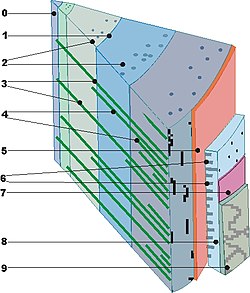Wood beam

Rays are shown as green stripes.
0 mark , 1 annual ring border , 2 resin canals , 3 primary rays, 4 secondary rays, 5 cambium , 6 bast rays , 7 cork cambium , 8 bast , 9 bark
Rays are part of the wood and run through the xylem from the inside of the wood to the cambium . They serve the radial supply of the wood body with water and nutrients. The wood rays extend over the cambium into the phloem and are called bast rays there .
Types of rays
If a wood ray begins directly in the pith of the wood, it is called the primary wood ray or medullary ray . If it begins in the xylem and not in the pith, it is called a secondary wood ray .
The single-row wood ray in secondary conducting tissues is exactly one cell wide. The aggregated ray of wood (composite ray of wood) consists of several cells.
Wood rays in hardwoods
In hardwoods, the rays of the wood are only made up of storage cells . Depending on the type of wood, they are single or multiple rows.
Only in some tropical wood species does the arrangement of the rays follow a regular pattern. Also resin canals that of epithelial cells are surrounded only come in some tropical woods in the wooden beams, and are then often filled with white or dark ingredients.
Wood rays have a volume fraction of approx. 8 to 33 percent on the hardwood body. There are also bushes with smaller rays.
Rays in conifers
The structure of wood rays in softwood is much more differentiated than in hardwoods. In wood species such as pine , spruce or larch , resin canals can always be found surrounded by epithelial cells. The structure is either homocellular from parenchymal cells or heterocellular from radiation parenchymal cells and transverse tracheids .
At the contact surfaces of the radial ray cells and the axially running longitudinal tracheids there are pits that allow water and nutrients to be transported. These intersecting field pits (in contrast to the pits in hardwoods) provide information on the type of wood.
The volume fraction of the wood rays in the softwood substance is up to one percent.
Functions
If the wood beam does not contain a resin channel, it is used to transport water and nutrients as well as to store reserve substances . At the same time, the wood rays increase both the strength and rigidity of the wood. Trees with many and thick rays are less likely to develop longitudinal cracks.
Softwoods such as B. Firs or yew trees that do not have resin canals can form traumatic resin canals in the event of a wound, as the parenchymal cells, which are also called epithelial cells or excretory cells in their special function, excrete resin under high pressure into the wood jet.
Optical effect
With different cuts (radial / tangential / axial), wood rays form differently on the wood surface. They are then referred to as “mirrors” and are often typical features of the respective type of wood. They are also used as design elements, especially for types of wood with clear wood rays.
literature
- Claus Mattheck: Stupsi explains the tree. Research Center Karlsruhe. 4th edition. Karlsruhe 2010, ISBN 978-3-923704-72-9 .
Web links
Individual evidence
- ↑ Ray F. Evert, Katherine Esau , Rosemarie Langenfeld-Heyser, Susan E. Eichhorn: Esau's plant anatomy: meristems, cells and tissues of plants - their structure, function and development . Walter de Gruyter, 2009, ISBN 978-3-11-020592-3 , p. 482.
- ↑ http://www.holzlexikon.de/lexikon.htm
- ↑ proHolz Austria
